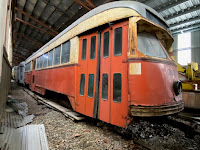Bill Wulfert has sent more photos from Winterfest, held this past weekend at the Seashore Trolley Museum, with this batch including many of Seashore's more commonly photographed pieces. Enjoy!
One of the denizens of Town House Shop at Seashore is
Bay State Street Railway 4175, an attractive semiconvertible built in 1914 by Laconia that later ran in Rhode Island and New Jersey. This car was the prototype for the replica that operates today in Lowell, Mass.
One of the cars in operation over the weekend was
Claremont Railway 4, the museum's diminutive line car.
One of three North Shore Line interurban cars at Seashore,
car 420 was built in 1928 as an open-platform observation car and later converted to a double-ended coach. It is currently out of service with a failed traction motor.
Fellow Highwood alum NSL 755 is a 1930 Standard product, shown here in both an exterior and an interior view.
Connecticut Company open car 303 was built by Brill in 1901 for the Winchester Avenue Railway. It's shown in Seashore's brand-new South Boston carbarn, a beautiful three-track, nine-berth structure that was just completed within the past few months.
One of Seashore's regular service stalwarts is
ConnCo 1160, shown here, a 1906 Stephenson suburban car that was completely restored by the museum. It's one of only nine Stephenson cars preserved and one of just four in operation.
The next two images show
Cleveland Railway 1227, which was one of the most recently completed of Seashore's famous frame-up restorations. Not only was this car received as a basket case, but it had been rebuilt by Shaker Heights Rapid Transit. Seashore did a lot of work to backdate it to its condition in the late 1910s.
There are three Chicago "Big Pullmans" preserved, and the only one not at IRM is
CSL 225. It's currently out of service with a failed motor.
DC Transit 1304 is a beautifully restored prewar PCC from the nation's capital. It's shown in the new South Boston carbarn. Unfortunately, at the moment it is out of service with a bad MG set.
Eastern Mass Street Railway 4387 is one of that system's distinctive suburban semi-convertible cars. It's been fully restored by Seashore but is currently out of service with a blown motor, I believe.
The most modern rapid transit cars at Seashore are
MBTA 0622-0623, shown here on display, built in 1979 by Hawker-Siddeley. They were operational until recently but I'm not certain of their current status. I believe that due to track conditions, Seashore isn't running heavy interurbans or rapid transit cars on their main line.
MBTA 5159 is one of several snow plows at Seashore that were converted from Type 3 semi-convertibles built in 1908.
Bill snapped this photo of a distinctive Boston third rail beam, shown on one of the Cambridge-Dorchester subway cars.
The
"City of Manchester" and
Atlantic Shore Line 100 are certainly among the prides of the fleet at Seashore, both the result of major multi-year restoration efforts. ASL 100 has the added distinction of having run over the museum's right-of-way during its service career.
The centerpiece of Town House Shop at the moment is
Portland-Lewiston 14, the "Narcissus," a 1912 Laconia-built interurban car that is the subject of a lengthy and involved restoration.
SEPTA 2278, aka "New Hampshire" since it was painted in Bicentennial colors in the 1970s, began life as Kansas City Public Service 781. It came to Seashore in 2012.
Twin City Rapid Transit 1267 is a beautifully restored standard car from Minnesota. Seashore restored it to its original "gate car" configuration, with an open rear platform and no passenger entry at the front. I'm not sure whether it's currently operational.
One of the photo lineups the museum set up was in front of the new South Boston barn with DC Transit 1304, featured earlier, and
Toronto 2890, a 1923 Ottawa-built Peter Witt acquired in 2000 from Halton County. The Witt has been the subject of recent work but is not currently operational.
A true masterpiece of restoration,
Wheeling Street Railway 639 is one of only two Cincinnati curve-siders in operation. It was restored - practically replicated - from the shell of a body and is one of the regular service cars at Seashore.
And to finish off, we'll add some property shots. Bill sent an exterior and an interior photo of Seashore's newest focus, the model railroad building. This was built by a sizable grant from one or two wealthy donors.
Here we are in the new South Boston carbarn, showing off features like the insulated walls, steel framing, wall-to-wall concrete and between-rails inspection pit. This replaces the older, smaller, and decidedly ramshackle South Boston barn, which was demolished a year or two ago.
And we'll finish with a couple of night photo shoots. First, the two operating ConnCo cars.
And here are 639, 1304, and 2890 in front of the new South Boston barn.



















































